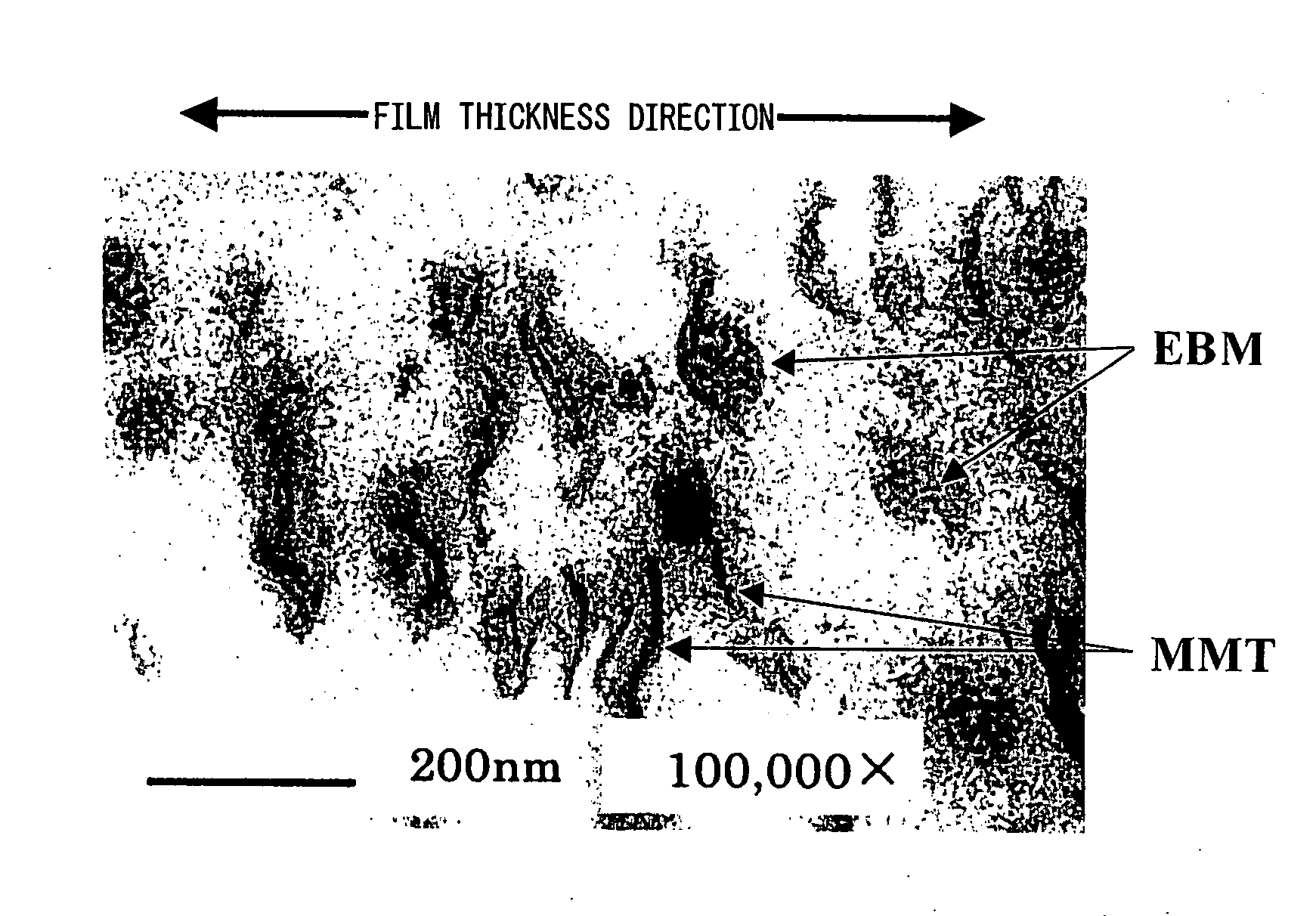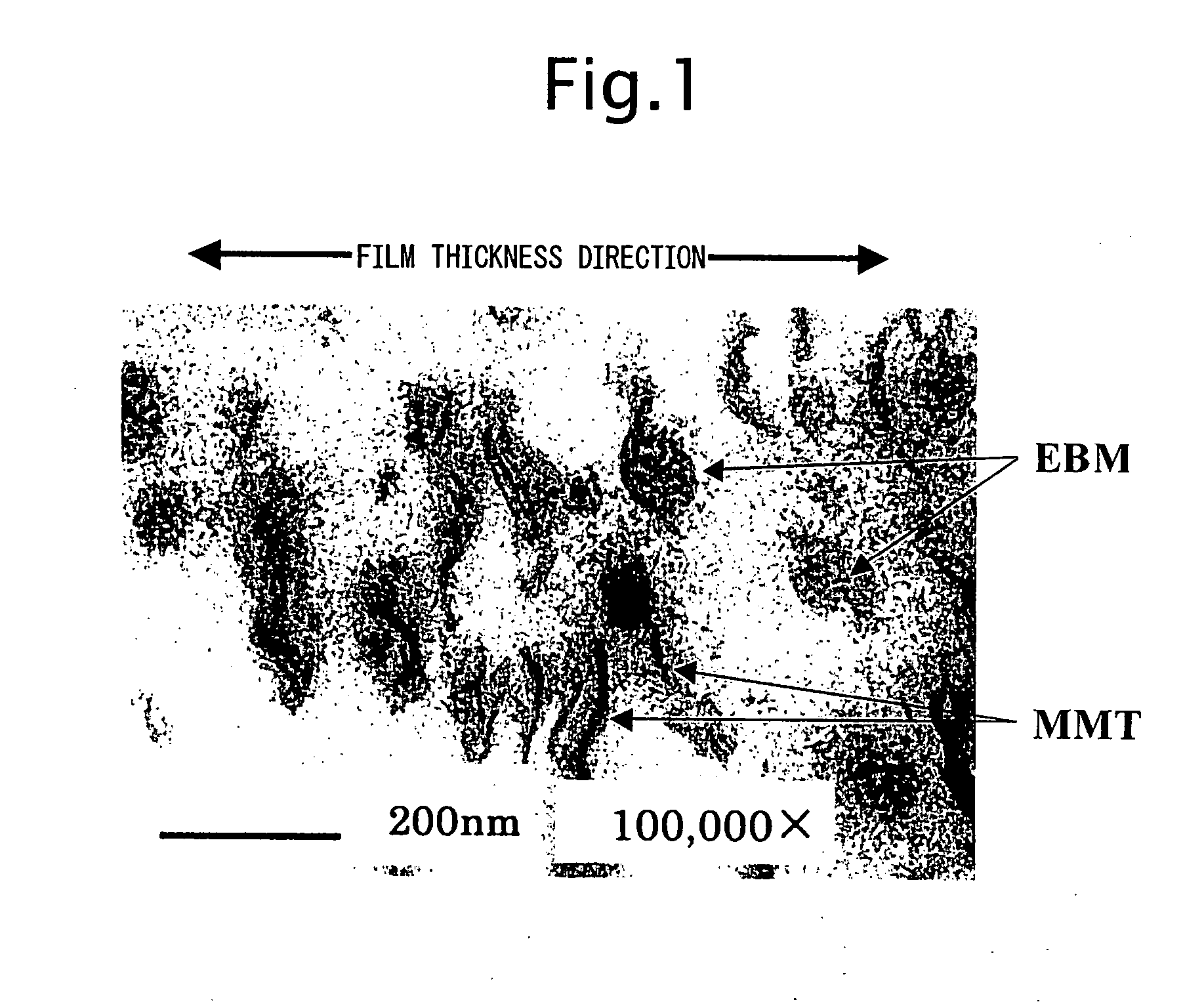Polyolefin-Based Resin Composition for Metal Coating, and Resin Film and Resin-Coated Metal Material Using the Same
a technology of polyolefin-based resin and metal coating, which is applied in the direction of synthetic resin layered products, coatings, transportation and packaging, etc., can solve the problems of poor adhesion to metal surfaces, cumbersome process, and insufficient adhesion force, so as to reduce the permeation of corrosion-causing substances, increase chemical bonding forces, and reduce the effect of separation
- Summary
- Abstract
- Description
- Claims
- Application Information
AI Technical Summary
Benefits of technology
Problems solved by technology
Method used
Image
Examples
examples 1 to 10
[0059] The raw materials shown in Table 1 or 2 were used as the polyolefin-based resin (A), the layered inorganic material (B), the olefin-based oligomer (C) containing a functional group having polarity, and the rubber-like elastic material (D).
TABLE 1Grade and MFR of Raw Materials Used in Examples1 to 5 and Comparative Examples 1 to 6ResinMFR (230° C.,ComponentName of Raw Material, Grade2.16 kg, JIS K6921)(A)Novatec PP EA7A, produced by1.4Japan Polypropylene Corp.(A′)PP-type Adomer QB540, produced1.1by Mitsui Chemicals, Inc.(B)Organomodified montmorillonite—(MMT), S-ben NX, produced byHojun Co., Ltd.(C)Maleic anhydride-modified PP,—U-mex 1001, produced by SanyoChemical Industries Co., Ltd.(D)Ethylene-butene rubber (EBM),8.02041P, produced by JSR Corp.
[0060]
TABLE 2Grade and MFR of Raw Materials Used in Examples6 to 10 and Comparative Examples 7 to 12ResinMFR (230° C.,ComponentName of Raw Material, Grade2.16 kg, JIS K6921)(A)Novatec HD HY331, produced by1.0Japan Polypropylene Corp...
examples 11 to 20
[0067] Using pellets of each of the resin compositions of Examples 1 to 10, a sheet (150×150×2.5 mm) was molded by an injection molding machine (melting temperature: 230° C., maximum shear rate: 1,000 / s) or an extrusion molding machine (melting temperature: 230° C., maximum shear rate: 100 / s) using a round die. Separately, a chromate treating agent was coated on the surface of a steel sheet (75×150×6 mm) subjected to degreasing and grid blasting, and then heat-treated at 160° C. Subsequently, the steel sheet was heated at 200° C. and an epoxy primer was coated on the surface. Thereafter, the sheet formed above was stacked and press-bonded thereon under heat at 200° C., whereby the sheet was bonded to the steel sheet surface. After adhesion, the steel sheet was cooled to room temperature by water-cooling it on the sheet surface.
[0068] This resin-coated steel sheet was immersed in a 3 mass % salt solution at 60° C. for 60 days, and then the sheet was forcebly separated by a hammer. T...
example 21
[0070] The raw materials shown in Table 5 were used as the polyolefin-based resin (A), layered inorganic material (B), olefin-based oligomer (C) containing a functional group having polarity and rubber-like elastic material (D).
TABLE 5Grade and MFR of Raw Materials Used in Example 21ResinMFR (230° C.,ComponentName of Raw Material, Grade2.16 kg, JIS K6921)(A)Novatec PP EA7A, produced by1.4Japan Polypropylene Corp.(B)Hydrotalcite, Kyoward 500,—produced by Kyowa ChemicalIndustry Co., Ltd.(C)Maleic anhydride-modified PP,—U-mex 1001, produced by SanyoChemical Industries Co., Ltd.(D)Ethylene-butene rubber (EBM),8.02041P, produced by JSR Corp.
[0071] First, 100 g of hydrotalcite in Table 5 was dispersed in 5,000 mL of water at 80° C. Subsequently, 28 g of sodium stearate was dispersed in 2,500 mL of water at 80° C., and the resulting solution was added to the hydrotalcite liquid dispersion prepared above, as a result, a precipitate was obtained. This precipitate was filtered, washed three...
PUM
| Property | Measurement | Unit |
|---|---|---|
| diameter | aaaaa | aaaaa |
| carbon number | aaaaa | aaaaa |
| carbon number | aaaaa | aaaaa |
Abstract
Description
Claims
Application Information
 Login to View More
Login to View More - R&D
- Intellectual Property
- Life Sciences
- Materials
- Tech Scout
- Unparalleled Data Quality
- Higher Quality Content
- 60% Fewer Hallucinations
Browse by: Latest US Patents, China's latest patents, Technical Efficacy Thesaurus, Application Domain, Technology Topic, Popular Technical Reports.
© 2025 PatSnap. All rights reserved.Legal|Privacy policy|Modern Slavery Act Transparency Statement|Sitemap|About US| Contact US: help@patsnap.com


